17.1 About the Detail portlet
The Detail portlet provides users with a detailed view of an entity’s attributes and their values. The portlet has two modes: display and edit. When accessing the Detail portlet, users can take advantage of its built-in capabilities to work with this information, including:
-
Section 17.1.3, Emailing entity data (display mode only)
-
Section 17.1.5, Linking to details of other entities (display mode only)
-
Section 17.1.6, Printing entity data (display mode only)
17.1.1 Displaying entity data
When accessed, the Detail portlet displays attribute data about a selected entity, such as a user or group. For example, here’s what the Detail portlet might display when user Bill Brown views his own information:
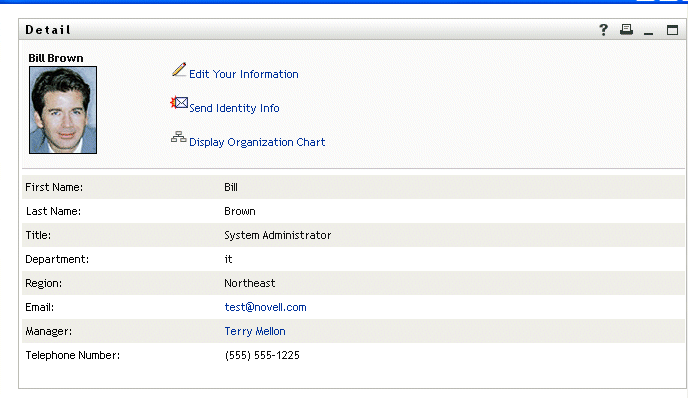
User images By default, the Detail portlet is configured to include the User Photo attribute. However, if your identity vault does not include this attribute or it is not populated, a default image is displayed at runtime. If you store your user images in a different location, you can configure the portlet to display them instead.
For more information, see Dynamically loading images.
Determining which attributes display
The Detail portlet displays only those attributes that:
-
Your directory abstraction layer data definitions make available for viewing
For more information on VDD configuration, see Section 4.0, Configuring the Directory Abstraction Layer.
-
Are specified in the Detail preferences
To learn about specifying which attributes display in the Detail portlet, see Section 17.5, Setting Preferences.
-
The current user has rights to view
For instance, managers with rights to the salary attribute will see that data, but other users won’t.
For more information, see Section 17.2.2, Assigning rights to entities.
-
Are currently populated with a value
Determining how attributes display
When displaying attributes, Detail formats the data as text, except in the following cases:
Determining what the heading area displays
You can lay out the heading area of the Detail portlet using standard HTML features:

The Detail preferences provide an HTML Layout Editor that you can use to create the look and content you want:
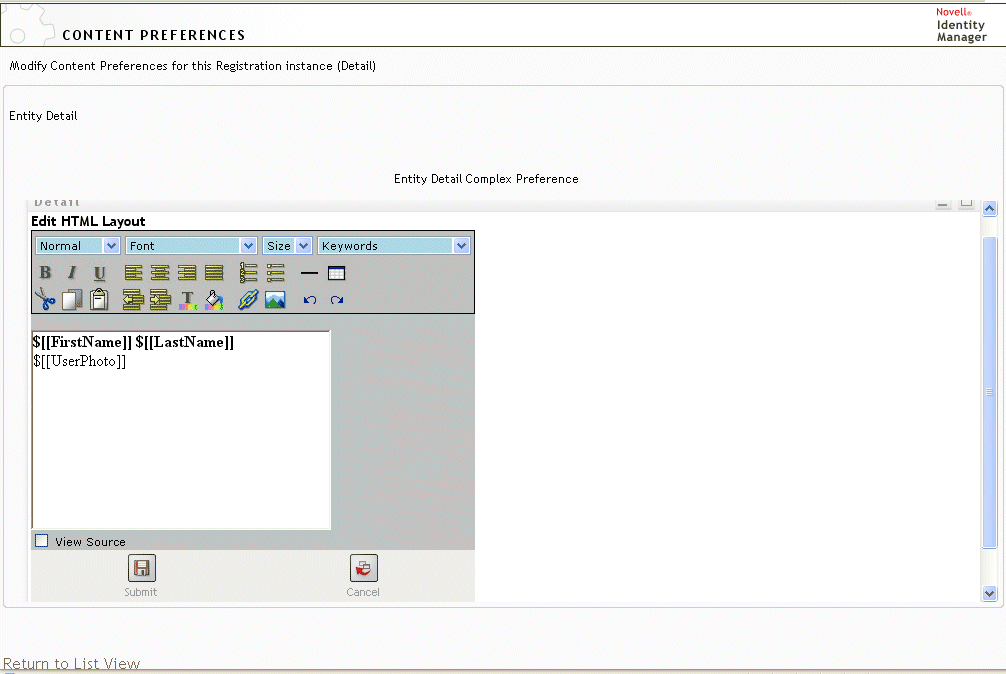
Using the HTML Layout Editor
The HTML Layout Editor provides the typical features of an HTML editor for defining text formatting and lists, and specifying anchors and images, and so on.
Keywords When designing your layout, you can use the Keywords dropdown to insert variables within the heading area of the Detail portlet to be replaced at runtime with specific attribute values. You can also type them using this syntax:
$[[keyword]]
Where keyword is the value of an attribute such as LastName.
You can concatenate attributes using this syntax:
$[[keyword+keyword]]
For example:
$[[FirstName+LastName]]
You can concatenate as many attributes as you want and can also include quoted strings like this:
$[[keyword+”sample text”+keyword]]
This will render the values of the keywords and the quoted text.
NOTE:When a keyword is mistyped in a layout, it will be rendered as-is at runtime (including the $[[]]).
Dynamically loading images To display images, such as user photos, that are stored in your identity vault, you can add the attribute name using the HTML Layout Editor. For example, adding the User Photo attribute to the displays the user’s photo. If you store images outside the identity vault, you’ll need to use the IMG: tag (from the View Source mode of the HTML Editor) as follows:
-
Go to the portlet’s preferences and access the HTML Editor.
-
Click View Source.
-
Use the IMG: tag to combine a location, an attribute key, and a file extension using a syntax like this:
$[[IMG:”URL” + attribute-key-name + ”fileextension”]]
The following example shows the syntax you’d use if you stored employee photos as JPG images by Last Name in the /images subdirectory of your application server:
$[[IMG:"http://myhost:8080/images/"+LastName+".jpg"]]
At runtime, the portlet concatenates the URL with the LastName attribute and the file extension .jpg.
Note that the HTML Editor supports a flexible syntax. It supports any combination of text and attributes so that the syntax is:
$[[IMG:”some text” + attribute-key-name + ...]]
17.1.2 Editing entity data
The Detail portlet automatically provides an Edit link (such as Edit Your Information or Edit User or Edit Device) to switch from display mode to edit mode. This enables users with appropriate rights for the current entity to change its attribute values and save those changes.
For example, here’s what Detail might display when user Bill Brown (who has the necessary rights) edits his own information:
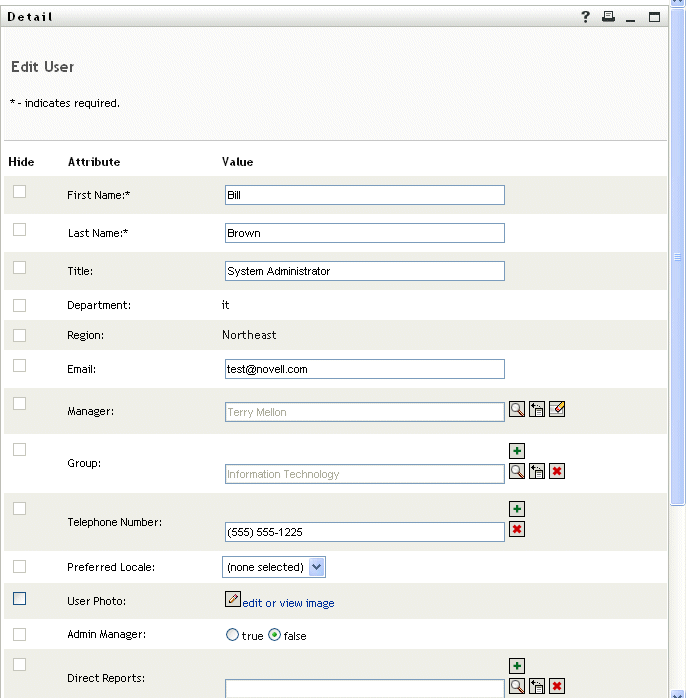
NOTE:For Boolean attributes, when both radio buttons are unselected it means that the attribute does not exist for the user. Checking the true or false radio button will both create the attribute for the user and set its value.
Determining which attributes display
In edit mode, the Detail portlet displays only those attributes that:
-
Your directory abstraction layer data definitions make available for viewing
For more information on data definitions, see Section 4.0, Configuring the Directory Abstraction Layer.
-
The current user has rights to view
For instance, managers with rights to the salary attribute will see that data, but other users won’t.
For more information, see Section 17.2.2, Assigning rights to entities.
An attribute must meet all of the above criteria in order to display in edit mode.
Determining how attributes display
In edit mode, Detail formats each editable attribute as a text box, except in the following cases:
Attributes that can’t be edited (either by definition or due to inadequate user rights) display as disabled or read only.
Validating changes
During editing, data validation is automatically performed for the following attribute type specifications:
-
Format: email
-
Data type: Integer
-
Control type: Range
When using a control type of local or global list, it is possible for the displayed list to include values that are outside of an attribute’s specified bounds. But such values will be flagged as out-of-range, and validation will prevent them from being submitted.
Defining a Default My Profile Entity
When defining an entity in the directory abstraction layer, you can specify a value for Default MyProfile Entity (in the Configuration element of the directory abstraction layer editor) to specify that another entity definition is to be used for editing. When switching from display mode to edit mode, the Detail portlet always checks whether this element is specified, then uses the appropriate entity definition to present the attributes.
For example, suppose the entity definition for Student includes user as the value for Default My Profile Entity. In this case, display mode will use the Student entity definition, but edit mode will use the user entity definition.
17.1.3 Emailing entity data
The Detail portlet automatically provides a link named Send Identity Info. Users can click it to email the URL of the current entity’s Detail to one or more other users. By emailing the Detail URL rather than the actual information, security is maintained (because anyone receiving the URL will need appropriate authority to use it).
17.1.4 Linking to an organization chart
The Detail portlet automatically provides a link named Display Organization Chart. Users can click it to display the Org Chart portlet for the current entity.
For example, if you’re viewing Detail for user Bill Brown, clicking this link displays:
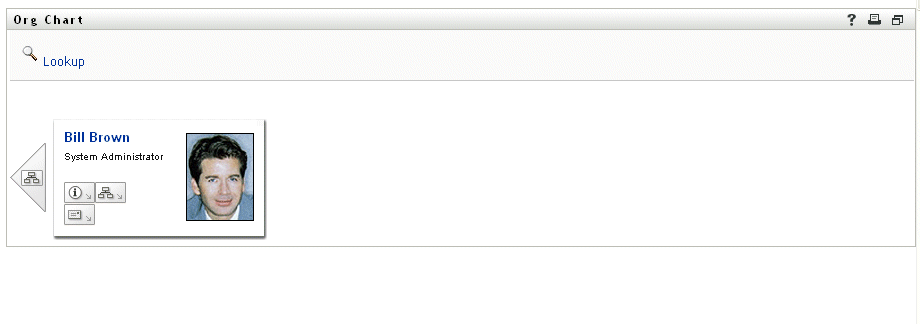
For more information on the Org Chart portlet, see Section 18.0, Org Chart Portlet Reference.
17.1.5 Linking to details of other entities
When configuring the Detail portlet, you may want to enable users to link to related entities from the current one. You can do that by including attributes that are defined (in your directory abstraction layer) with the control type DNLookup.
When the Manager attribute is displayed in a user’s Detail, it appears as a link. Clicking that link displays Detail for the Manager.
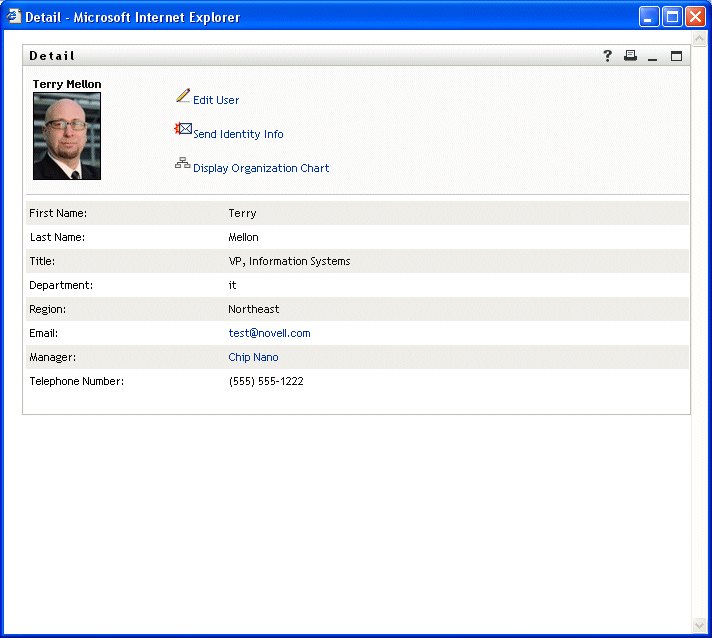
For more information on the directory abstraction layer, see Section 4.0, Configuring the Directory Abstraction Layer.
To learn about specifying which attributes display in the Detail portlet, see Section 17.5, Setting Preferences.
17.1.6 Printing entity data
By default, the display settings for the Detail portlet enable the Print option on the portlet’s title bar. If you keep Print enabled, users can click it to display a printer-friendly version of the Detail content:
To change this or other settings for the Detail portlet, use the Administration tab to update the Portlet Registration for DetailPortlet (on the Portlet Administration page).
For more information, see Section 9.0, Portlet Administration.